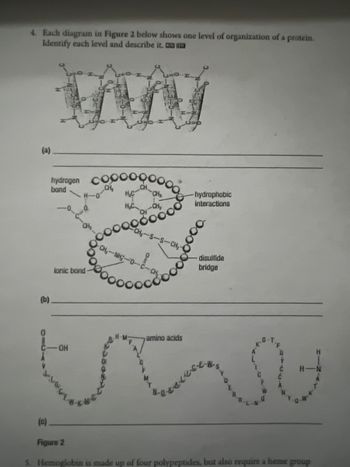
Human Anatomy & Physiology (11th Edition)
11th Edition
ISBN: 9780134580999
Author: Elaine N. Marieb, Katja N. Hoehn
Publisher: PEARSON
expand_more
expand_more
format_list_bulleted
Concept explainers
Question

Transcribed Image Text:4. Each diagram in Figure 2 below shows one level of organization of a protein.
Identify each level and describe it. CA ITA
(a)
(b)
0
hydrogen co
CH₂
bond
H-0
(c)
-0, 0
lonic bond
C-OH
H₂C
H₂C
CH-CH₂
amino acids
-hydrophobic
interactions
disulfide
bridge
Figure 2
5. Hemoglobin is made up of four polypeptides, but also require a beme group
Expert Solution
arrow_forward
Step 1
Biological macromolecules are the substances that are needed in enough amount for the body.
Biological macromolecules are as :-
I ) Carbohydrate
II) Proteins
III) Fats / lipids
IV) Nucleic acid
Step by stepSolved in 5 steps

Knowledge Booster
Learn more about
Need a deep-dive on the concept behind this application? Look no further. Learn more about this topic, biology and related others by exploring similar questions and additional content below.Similar questions
- Match the unique dehydration bonding that occurs with each specific macromolecule. [Choose ] this option is for nucleic acids peptide bond ester linkage glycosidic linkage Carbohydrates [ Choose ] Proteins [ Choose ] lipids [ Choose ] nucleic acids [ Choose ] > > >arrow_forwardWhich of the numbered bonds in this polypeptide fragment are peptide bond(s)? (Select all that apply!)arrow_forwardPart C - Classifying molecules by their functional groups Functional groups confer specific chemical properties to the molecules of which they are a part. In this activity, you will identify which compounds exhibit certain chemical properties as well as examples of those six different compounds. Drag one molecule and one chemical property to each bin. If one property can apply to more than one functional group, choose the best answer for each functional group. ▸ View Available Hint(s) forms HHO disulfide H-C C-C-O-H HHO H-C-C-C-H acts as a base bonds A A H A contributes negative charge HH H -S-H HH HH A alcohol carboxylic acid aldehyde 0 C-0- P-0- thiol is polar and makes compounds HHH | | | may H-C-C-C-H structura more soluble HNH of a k in water H H acts as an acid aminearrow_forward
- Which of the following are not driving forces for protein folding? Salt Bridges Conformational Entropy Entropy of the Solvent Internal Hydrogen Bonding Disulfide Bonds i. ii. iii. iv. V. O i, iii, iv O ii, iii, iv, v O ii, v Oi, v Oi, ivarrow_forward1- (True or False) Adjacent nucleotides are joined by covalent bonds that form between the –OH group on the 3` carbon of one nucleotide and the phosphate on the 5` carbon on the next. 2- (True or False) if a solute is in an aqueous solution, then by definition an hydration shell has formed around it. 3- (True or False) When exposed to water, phospholipids will self-organize into lipid bilayers, and spheres.arrow_forwardWhich of the following molecules is an example of a monomer that makes up a protein polymer? 1 2 3 4 5arrow_forward
arrow_back_ios
arrow_forward_ios
Recommended textbooks for you
 Human Anatomy & Physiology (11th Edition)BiologyISBN:9780134580999Author:Elaine N. Marieb, Katja N. HoehnPublisher:PEARSON
Human Anatomy & Physiology (11th Edition)BiologyISBN:9780134580999Author:Elaine N. Marieb, Katja N. HoehnPublisher:PEARSON Biology 2eBiologyISBN:9781947172517Author:Matthew Douglas, Jung Choi, Mary Ann ClarkPublisher:OpenStax
Biology 2eBiologyISBN:9781947172517Author:Matthew Douglas, Jung Choi, Mary Ann ClarkPublisher:OpenStax Anatomy & PhysiologyBiologyISBN:9781259398629Author:McKinley, Michael P., O'loughlin, Valerie Dean, Bidle, Theresa StouterPublisher:Mcgraw Hill Education,
Anatomy & PhysiologyBiologyISBN:9781259398629Author:McKinley, Michael P., O'loughlin, Valerie Dean, Bidle, Theresa StouterPublisher:Mcgraw Hill Education, Molecular Biology of the Cell (Sixth Edition)BiologyISBN:9780815344322Author:Bruce Alberts, Alexander D. Johnson, Julian Lewis, David Morgan, Martin Raff, Keith Roberts, Peter WalterPublisher:W. W. Norton & Company
Molecular Biology of the Cell (Sixth Edition)BiologyISBN:9780815344322Author:Bruce Alberts, Alexander D. Johnson, Julian Lewis, David Morgan, Martin Raff, Keith Roberts, Peter WalterPublisher:W. W. Norton & Company Laboratory Manual For Human Anatomy & PhysiologyBiologyISBN:9781260159363Author:Martin, Terry R., Prentice-craver, CynthiaPublisher:McGraw-Hill Publishing Co.
Laboratory Manual For Human Anatomy & PhysiologyBiologyISBN:9781260159363Author:Martin, Terry R., Prentice-craver, CynthiaPublisher:McGraw-Hill Publishing Co. Inquiry Into Life (16th Edition)BiologyISBN:9781260231700Author:Sylvia S. Mader, Michael WindelspechtPublisher:McGraw Hill Education
Inquiry Into Life (16th Edition)BiologyISBN:9781260231700Author:Sylvia S. Mader, Michael WindelspechtPublisher:McGraw Hill Education

Human Anatomy & Physiology (11th Edition)
Biology
ISBN:9780134580999
Author:Elaine N. Marieb, Katja N. Hoehn
Publisher:PEARSON

Biology 2e
Biology
ISBN:9781947172517
Author:Matthew Douglas, Jung Choi, Mary Ann Clark
Publisher:OpenStax

Anatomy & Physiology
Biology
ISBN:9781259398629
Author:McKinley, Michael P., O'loughlin, Valerie Dean, Bidle, Theresa Stouter
Publisher:Mcgraw Hill Education,

Molecular Biology of the Cell (Sixth Edition)
Biology
ISBN:9780815344322
Author:Bruce Alberts, Alexander D. Johnson, Julian Lewis, David Morgan, Martin Raff, Keith Roberts, Peter Walter
Publisher:W. W. Norton & Company

Laboratory Manual For Human Anatomy & Physiology
Biology
ISBN:9781260159363
Author:Martin, Terry R., Prentice-craver, Cynthia
Publisher:McGraw-Hill Publishing Co.

Inquiry Into Life (16th Edition)
Biology
ISBN:9781260231700
Author:Sylvia S. Mader, Michael Windelspecht
Publisher:McGraw Hill Education